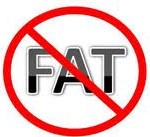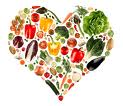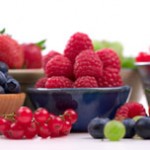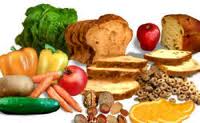Posts Tagged ‘fruit’
Monday, August 29th, 2011
Eating too much fat increases amongst other things your risk of heart disease and encourages weight gain.
Research has shown that our diet generally contains too much fatty food and that we can all benefit from eating less fat.
Instead of getting our energy from starchy foods (carbohydrates) like bread and potatoes, we rely too much on foods that are high in animal fats such as red meat, butter and cheese.

Tips for reducing fat intake:
- Choose lean meat. Trim all visible fat from meat and poultry prior to cooking.
- Choose low fat milk; choose semi-skimmed or skimmed milks.
- Choose low fat yoghurts.
- Choose low fat spread.
- Fry very occasionally using olive, sunflower or rapeseed oil. Choose grilling or baking instead.
- Beware of the hidden fats in biscuits, cakes, chocolate, pastry and savoury snacks. Always read your food labels.
- Fill up on fruit and vegetables.
- Look out for low fat snacks, low fat yoghurt and fruit.
- Use oven chips rather than fried.
Tags: calories, carlow, diet, fat, food label, fruit, healthy eating, kilkenny, lose weight, low fat, nutrition, nutritional concepts, vegetables
Posted in General | Comments Off
Monday, July 18th, 2011
- Eat fewer fried and fatty foods such as cream, butter, full-fat dairy products, fatty red meat, cakes, biscuits and takeaways – and find lower-fat alternatives instead.
- If you have to use oil, go for one that is packed with monounsaturates such as olive oil or rapeseed oil.
- Eat five servings of fruit and vegetables every day – they are low in fat and calories but will help to fill you up.
- Go for high-fibre carbohydrates such as wholemeal bread, wholegrain cereals, brown rice and wholewheat pasta. They are far more filling than the white stuff.
- Start your day with a bowl of porridge.

- Use a little less meat in dishes like stews, soups and casseroles and add barley, lentils or beans instead.
- Eat oily fish once a week. Lunch on sardines with toast or serve salmon for dinner.
- Slash the salt content of your diet – check salt levels before you buy.
- If you drink, stick to sensible limits – that means no more than 3-4 units a day for men and 2-3 units daily for women.
Tags: 5 a day, alcohol, carlow, diet, energy, fat, fruit, healthy eating, healthy heart, kilkenny, low fat, nutrition, nutritional concepts, portion, vegetables, vitamins and minerals
Posted in General | Comments Off
Monday, July 4th, 2011
The best way to eat if you want to banish tiredness is to have a healthy, balanced diet that contains foods from four main food groups in the right proportions.
The four food groups are:
- potatoes, bread, rice, pasta and other starchy foods
- fruit and vegetables
- milk and dairy foods
- meat, fish, eggs, beans and other non-dairy sources of protein

- Eat at regular intervals.
- Start the day well with breakfast.
- Aim for 5 a day with fruit and vegetables.
- Say no to sugar.
- Watch your intake of alcohol.
- Eat enough for your activity level.
Tags: 5 a day, activity, alcohol, calories, carlow, diet, energy, fruit, healthy eating, kilkenny, nutrition, nutritional concepts, sugar, vegetables
Posted in General | Comments Off
Monday, June 20th, 2011
The school holidays are fast approaching and they can be associated with a lack of routine which can mean that there are more opportunities to eat more food more often. Here are some tips to avoid over-indulging in fatty, sugary, salty and pre-packaged foods that can be tempting alternatives during the holidays.

- Encourage your kids to maintain their school-eating schedule. This can help to stop grazing between meals. Try to stick to a nutritious breakfast, lunch and dinner as well as healthy morning and afternoon snacks.
- When packing the swimming gear or getting ready for the walk to the park, throw in some fresh fruit and vegetables to help with the hunger pangs.
- Encourage your kids to drink more water, rather than fizzy drinks.
- Focus on more activity to help counteract any increased food intake.
- Keep kids occupied as much as possible. Boredom can play a big part in snacking, overeating and drinking.
- Help make mealtimes fun. Let your kids help to plan and prepare a meal.
Tags: activity, carlow, diet, fruit, fun, healthy eating, holidays, kids, kilkenny, nutrition, nutritional concepts, school, snack
Posted in General | Comments Off
Monday, June 6th, 2011
Berries are some of the most healthy foods, and summer is the season of the berry. Besides being delicious, berries are low in fat and calories, but high in fibre, vitamins, minerals, and antioxidants, these not only contribute to overall health, but may even help prevent cancer and heart disease. They are more affordable in summer, being in season and thanks to the freezer, we can have the advantages of berries year-round.

Ideas for Serving Berries
Most berries like strawberries, blueberries and raspberries are sweet enough to be served just as they are; however, here are some more ideas:
- Add strawberry slices to a bowl of whole grain cereal
- Sprinkle blueberries on a salad
- Stir fresh raspberries into yoghurt
- Combine frozen berries with bananas and low-fat milk to make a smoothie
Tags: 5 a day, berries, calories, carlow, fruit, healthy eating, kilkenny, low fat, nutrition, nutritional concepts, snack, summer, vitamins and minerals
Posted in General | Comments Off
Monday, March 28th, 2011
Whether you have taken up running to lose weight, to improve fitness or to relieve stress , you will find that there are many benefits. When it comes to running, it is important to fill your body with a good quality diet that can help sustain your energy levels. It is important to eat a balanced diet that includes carbohydrate, protein and fat.
, you will find that there are many benefits. When it comes to running, it is important to fill your body with a good quality diet that can help sustain your energy levels. It is important to eat a balanced diet that includes carbohydrate, protein and fat.
Carbohydrate
Carbohydrate foods help you maintain your energy during a run and they should be eaten both before and after. The highest quality carbohydrates are rich in fibre which helps to keep you feeling full. Carbohydrates to choose from include whole wheat pasta, potatoes, wholegrain rice and bread.
Protein
Protein is essential for muscle and satisfies hunger by providing a feeling of fullness. Quality sources of protein include skinless turkey and chicken, fish fillet, egg whites, low fat cheese, low fat yoghurt and skimmed/semi-skimmed milk.
Fat
While most runners are looking to cut out fat, it is important to remember that you need to include some fat in your diet. However, the fat should be of the healthy variety such as olive oil, unsalted nuts, avocados, sunflower seeds, light mayonnaise and fat-free salad dressings are good fat sources for runners.
In terms of an eating routine, it is better to eat smaller portions more often than larger portions three times a day. Also, remember to drink water regularly. Even if work or taking care of the kids makes breakfast a difficult time to sit down and eat, don’t go hungry. At the very least, eat some fruit on the move.
Tags: 5 a day, activity, balanced diet, carbohydrate, carlow, diet, energy, fat, fruit, healthy eating, kilkenny, lose weight, nutrition, nutritional concepts, protein, running, Sport
Posted in Sport | Comments Off
Monday, March 14th, 2011
Do you usually wear green on St. Patrick’s Day? It is a fun tradition, but this year take it a step further and make an effort to eat green foods as well. It is easy to come up with some green foods to try but here are some ideas to get you started.
For breakfast prepare a spinach omelette, by scrambling eggs and added some fresh or thawed frozen spinach to it. Or maybe try some pancakes with some sliced of green apple or kiwi.

How about having a green salad for lunch? Add some chicken or ham and cheese to make it more filling.
For dinner, try some grilled chicken and potatoes with a big serving of steamed broccoli.
Why not keep the green theme for dessert? Try some green sugar free jelly or fruit salad made with mostly green fruit would be another great dessert idea.
Tags: carlow, fruit, fun, green, healthy eating, kilkenny, nutrition, nutritional concepts, st.patrick's day
Posted in General | Comments Off
Monday, February 14th, 2011
Fibre is found in foods which originate from plants, such as cereals, grains, seeds, pulses, fruit and vegetables. To increase the amount of fibre you eat, you need to have more of these types of food as part of your diet.
There are two types of fibre: soluble and insoluble. Most foods contain a mixture of both.
It is a good idea to try to eat more fibre because most people in Ireland don’t have enough fibre in their diets. Insoluble fibre helps prevent constipation, and soluble fibre may help to reduce the amount of cholesterol in the blood.
Wholegrain varieties of starchy foods, such as wholemeal bread, wholegrain breakfast cereals, brown rice and wholegrain pasta, are particularly good sources of insoluble fibre.
Brussels sprouts, potatoes, cabbage, and carrots are all good sources of fibre, and so are beans and pulses, such as red kidney beans, baked beans, broad beans, butter beans, green beans, chickpeas, green lentils and black-eyed beans. Dried fruit – such as figs, apricots, prunes and dates – are also a good choice. Or try eating pears, apples, cranberries, avocados, pomegranates and blackberries.
When you have plenty of fibre in your diet, you need to make sure that you drink plenty of fluids – at least six to eight glasses a day. It is especially important to have plenty of water if you are constipated because fluids will help to keep things moving! If you get constipated a lot, talk to your GP.
Tags: 5 a day, activity, calories, carbohydrate, carlow, drinking, fibre, fruit, healthy eating, kilkenny, nutrition, nutritional concepts, portion, starchy, vegetables, vitamins and minerals
Posted in General | Comments Off
Monday, November 15th, 2010
Breakfast means “breaking the fast”. After a nights rest, eating gives you energy to spark the body into life again.
Breakfast also cuts down on mid morning ‘snack attacks’.
No time for breakfast?
- Set the alarm 5 minutes earlier.
- Make the sandwich the night before, pop it in the fridge, and eat it when you get to school / work with a carton of orange juice.
- A glass of milk and a banana are very quick and easy to eat.
- Fruit can be eaten on the way to school / work. Try bananas, apples, pears, peaches, etc.
Cereal and Milk
- Healthy choices – Shredded Wheat, Weetabix, Shreddies, Puffed Wheat, Fruit ‘n’ fibre, Porridge, Ready Brek, Rice Krispies, Cornflakes.
- Try not to add sugar, have sliced banana or sprinkle raisins instead. If you can’t do without, sprinkle less sugar or try an artificial sweetener instead.
- Sugar coated cereals may damage your teeth, so have these only as an occasional treat.
Toast, bread or muffins
- Choose wholegrain, high fibre white or malted grain varieties.
- Try peanut butter, sliced banana or just a thin scrape of jam or marmalade.
- Easy to eat on the move or on the way to school / work.
- Use only a thin scraping of butter, margarine or a low fat spread.
Cooked breakfast
- Can be healthy, but choose wisely.
- Try grilled tomatoes and mushrooms or baked beans on toast.
- Don’t fry your breakfast – try grilling bacon or low fat sausages and scrambling the egg.
Tags: breakfast, carlow, energy, fruit, healthy eating, kilkenny, nutrition, nutritional concepts, portion, snack, sugar
Posted in General | Comments Off
Monday, August 9th, 2010
Eating a healthy balanced diet will provide you with all the nutrients you need to take part in your favourite sport or activity.
This means eating a wide variety of foods, see below for how to get the balance right.
If you take part in a sport regularly, perhaps you’re a member of a club or team, or a regular at your local gym, then the best way to get the most out of your sport is to:
- drink plenty of fluids
- eat plenty of fruit and vegetables
- eat plenty of starchy foods (carbohydrate) to keep you going during exercise such as rice, bread, pasta (try to choose wholegrain varieties when you can) and potatoes.
- eat some protein-rich foods such as meat, fish, eggs and pulses
- have some milk and dairy foods
- just eat a small amount of foods high in fat, salt and sugar
- eat enough food for your level of activity. If you eat too little then you won’t be able to keep up your exercise levels
It is important to eat a variety of these foods to make sure we get all the nutrients our bodies need.
Timing of meals around workouts is just as important as what you eat if you want to keep your energy levels up. For the first two hours after exercise, muscles can refuel their glycogen stores twice as fast as normal so it’s important to eat carbohydrate-containing foods as soon as possible after a workout or exercise session.
See my next blog for more on starchy foods for exercise.
Tags: activity, carbohydrate, carlow, fruit, healthy eating, kilkenny, nutritional concepts, portion, Sport, team, vegetables, vitamins and minerals
Posted in Sport | Comments Off










